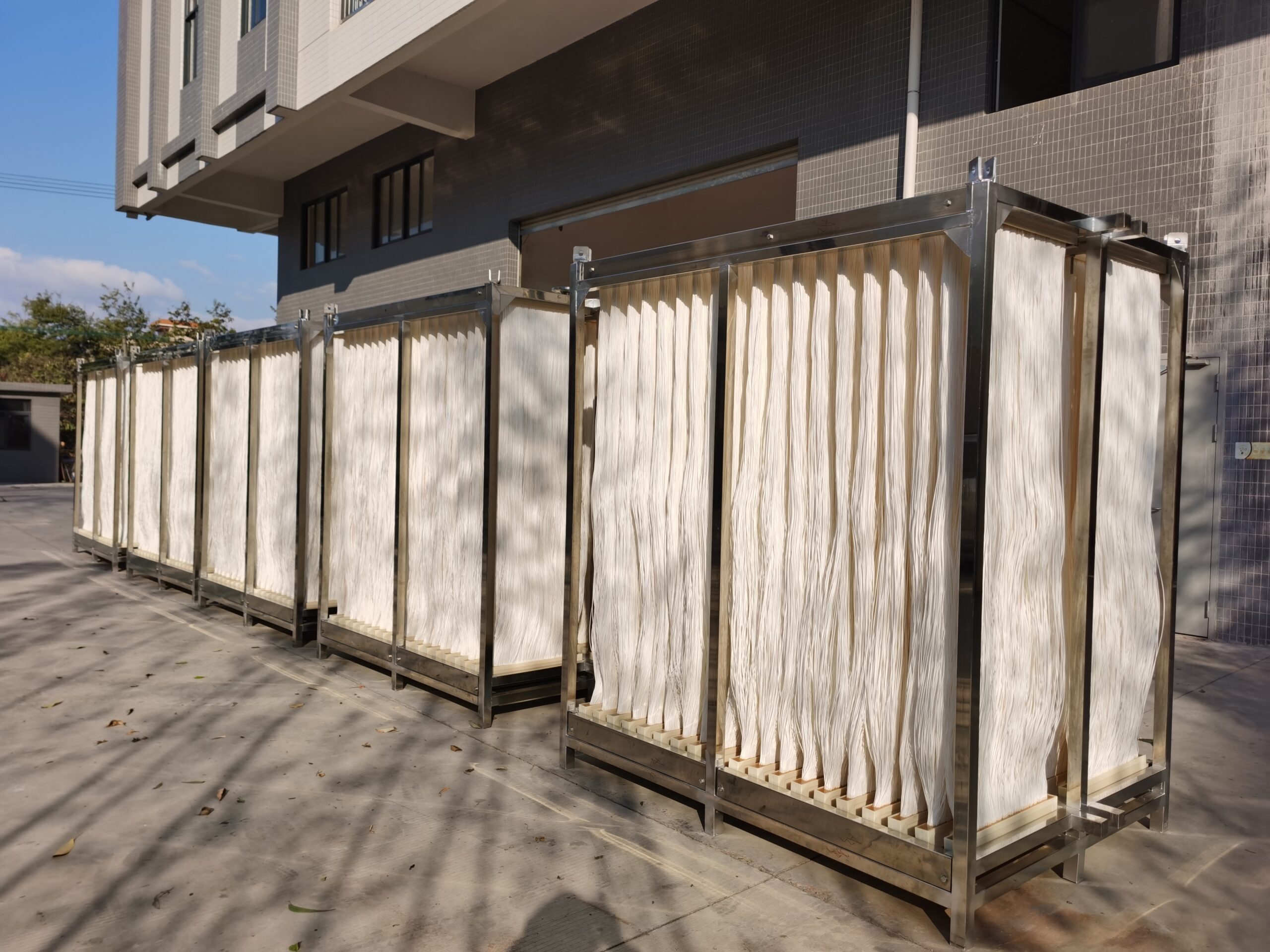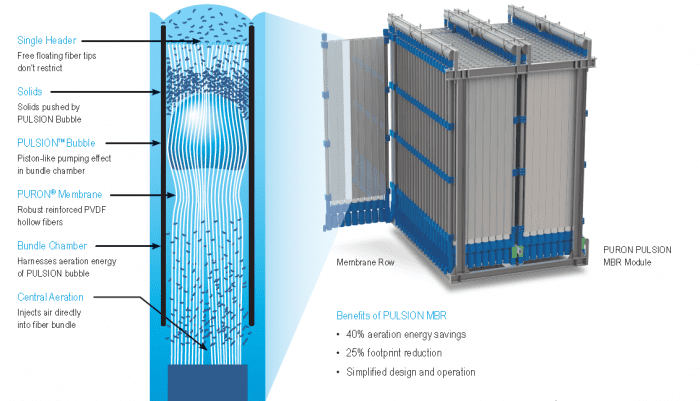How Membrane Bioreactor Technology Is Revolutionizing Wastewater Treatment
How Membrane Bioreactor Technology Is Revolutionizing Wastewater Treatment
Blog Article
Exactly How Membrane Layer Bioreactors Are Changing Water Purification Systems
The introduction of membrane bioreactors (MBRs) represents a significant improvement in the field of water filtration, combining biological therapy procedures with innovative membrane filtration technologies. This integration not just boosts the quality of dealt with effluent but also addresses urban space restrictions, making MBRs particularly ideal for densely inhabited areas. As worldwide water scarcity magnifies, the role of MBRs in assisting in safe and clean water reuse and sustainable water administration ends up being progressively critical. The implications of this technology expand beyond effectiveness-- what chances and obstacles lie in advance for its widespread implementation?
Introduction of Membrane Layer Bioreactors
Membrane layer bioreactors (MBRs) stand for a substantial improvement in water purification modern technology, as they incorporate biological treatment processes with membrane layer filtration. This integration boosts the effectiveness of wastewater treatment by using microorganisms to degrade organic toxins while at the same time employing semi-permeable membranes to different treated water from suspended solids and pathogens.
The MBR system commonly is composed of an organic reactor where the microbial populace metabolizes pollutants, followed by a membrane filtration unit that preserves biomass and allows only clean water to pass through. This double functionality causes greater effluent high quality contrasted to conventional therapy methods. MBRs can be operated in both set and continual flow modes, providing versatility in design and application.
In Addition, MBRs are defined by their compact footprint, making them appropriate for urban settings with space restraints. Membrane Bioreactor. They also enable the recovery of water for reuse, therefore contributing to water sustainability initiatives. While MBR innovation has gotten popularity in municipal and industrial applications, its operational complexities and power needs necessitate mindful consideration throughout execution. Overall, MBRs go to the center of improving water therapy performance and quality, showcasing the capacity for ingenious options in ecological administration.
Advantages of MBR Modern Technology
The assimilation of biological therapy with membrane layer purification offers various benefits for water purification processes. Among the key advantages of Membrane layer Bioreactor (MBR) modern technology is its capacity to properly remove both organic and not natural pollutants, resulting in high-quality effluent. The membrane layers act as a physical obstacle, preventing put on hold solids and microorganisms from going through, which improves the total safety and security and integrity of treated water.
In addition, MBR systems require a smaller sized footprint compared to traditional therapy approaches, enabling more effective area application. This portable design is particularly helpful in urban settings where land is restricted. MBRs also show operational flexibility, accommodating differing influent high qualities and flow prices without considerable performance deterioration.
Moreover, the procedure provides enhanced nutrient elimination capabilities, especially for nitrogen and phosphorus, which are essential for preventing eutrophication in getting waters. The lowered sludge manufacturing connected with MBR innovation likewise equates to reduce disposal expenses, making it a cost-efficient solution over time - Membrane Bioreactor. In general, the advantages of MBR technology placement it as a leading selection for ingenious and sustainable water filtration systems, addressing both ecological and economic concerns
Applications in Water Purification
Applications of Membrane Layer Bioreactor (MBR) technology in water filtration are varied and impactful, attending to various therapy needs throughout several markets. MBRs effectively integrate organic therapy procedures with membrane filtering, making them ideal for local wastewater treatment, commercial effluent administration, and even safe and clean water reuse initiatives.
In municipal setups, MBRs are increasingly used to improve the quality of dealt with wastewater, permitting conformity with stringent discharge regulations and promoting the recycling of water for watering and non-potable usages. Their small style additionally makes them suitable for metropolitan settings where room is restricted.
Industrially, MBR innovation is utilized to treat procedure water and wastewater, particularly in fields such as food and beverage, drugs, and textiles. By successfully removing pollutants and suspended solids, MBRs aid industries decrease ecological influences while recouping valuable resources from wastewater streams.
Furthermore, MBRs are obtaining grip in decentralized water therapy applications, where small systems can be deployed in remote locations or creating areas. This versatility makes it possible for communities to achieve lasting water monitoring have a peek at this website options, enhancing accessibility to tidy water while minimizing reliance on traditional treatment methods.
Study and Success Stories

In another example, a textile production facility in Bangladesh adopted MBR technology to resolve its wastewater difficulties. The system decreased chemical oxygen need (COD) levels from 1,200 mg/L to less than 100 mg/L, thus meeting governing criteria and considerably minimizing environmental influence.
The University of Cape Town's MBR setup has shown efficient in treating greywater for non-potable reuse on school. This project not only saves drinkable water yet additionally works as an academic design for lasting practices.
Furthermore, a fish and shellfish handling plant in Norway used MBR modern technology to deal with effluents consisting of high levels of organic issue, accomplishing over 90% pollutant removal. These situation studies navigate to these guys emphasize MBR modern technology's convenience and its important function in boosting water high quality across varied applications.
Future of Water Treatment Solutions
As international water scarcity and contamination difficulties escalate, innovative water treatment solutions are ending up being significantly important to make sure sustainable accessibility to clean water. The future of water treatment hinges on the combination of sophisticated modern technologies that enhance the effectiveness and efficiency of filtration procedures. Membrane layer bioreactors (MBRs) are at the forefront of this advancement, incorporating organic therapy with membrane purification to generate top notch effluent ideal for different applications.

Arising trends such as source healing from wastewater, including nutrients and energy, will certainly additionally change treatment facilities into environmentally friendly centers. Furthermore, innovations in nanotechnology and membrane products assure improved performance and long life of filtration systems.

Conclusion
Their duty in potable water reuse and lasting water management highlights their importance in addressing worldwide water deficiency obstacles. Continued research and advancement will certainly additionally improve the effectiveness and fostering of MBR technology, guaranteeing a resistant future for water therapy services.
The introduction of membrane bioreactors (MBRs) stands for a considerable advancement in the area of water purification, combining organic treatment processes with advanced membrane filtration technologies. As international water scarcity increases, the duty of MBRs in assisting in safe and clean water reuse and sustainable water administration ends up being increasingly essential. They also make it possible for the recuperation of water for reuse, thus contributing to water sustainability initiatives.As global water scarcity and pollution difficulties intensify, cutting-edge water therapy solutions are ending up being increasingly crucial to make certain sustainable access to tidy water. Their function in safe and clean water reuse and sustainable water monitoring highlights their relevance in dealing with worldwide water scarcity difficulties.
Report this page